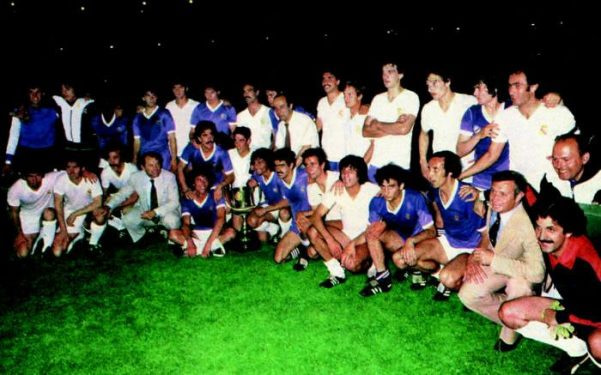The 1979/80 Copa del Rey final was one of the strangest nights in the long and successful history of Real Madrid football club.
The Spanish giants had already secured their 20th league title a month earlier and, having reached the last stage of the cup competition were hopeful of doing the double.
To walk away with the trophy, the club would have to topple a familiar foe — their own ‘B’ team, Real Madrid Castilla.
The unlikely finalists had romped their way through the early rounds, dispatching lower league clubs with ease.
However, things got a whole lot harder in the later rounds, with the club knocking out four top-flight clubs on their way to the final.
After squeezing past La Liga strugglers Hercules CF in the fourth round, they went on to beat Athletic Bilbao, who had finished in seventh place.

Real Madrid Castilla famously reached the 1980 Copa del Rey final.
It was the quarter and semi-finals where Castilla impressed, as they topped Real Sociedad and Sporting de Gijón, who had finished second and third in La Liga.
While the club were unable to pull off a similar shock result against their masters, suffering a 6-1 defeat in front of a capacity crowd of 65,000 at the Bernabeu, their incredible feat did earn them a place in the 1980/81 European Cup Winners’ Cup.
Unsurprisingly, Real Madrid Castilla’s incredible season was a rarity.
While they have never achieved anything close to what they did that year again the club is still viewed as a valuable part of the Real Madrid system. But why is that?
What are football club B teams, what is their purpose and just how effective are they?
What are B Teams?
In simple terms, B teams are a cross between a reserve team and a feeder club.
While they are part of the same club, both teams feature within the league system, playing week in, week out and competing for trophies.
As a reserve team, clubs such as Barcelona and Real Madrid have been given special privileges by the Spanish Football Association.
This allows them to transfer players to and from their B teams throughout the season, even when the transfer window is closed.
However, to keep things fair, B teams are barred from playing in the same division as their senior side.
For example, when Castilla and Bilbao Athletic, (the reserve team of La Liga side Athletic Bilbao), finished in first and second place in the 1983/84 Segunda Division season.
It was Hercules CF, Racing de Santander and Elche CF, who finished third, fourth and fifth respectively, who gained promotion to the top flight.
The decision meant that clubs could use their B teams to benefit their senior teams.
They could field a weakened squad when the two teams meet, for example, or transfer all of their best players to the B team when they face tougher opponents.
Goal Profits Academy is our complete football trading course. Learn how to trade, based on proven methods that we’ve been using successfully for many years.
Which Countries Have B Teams?
There are a large number of countries that allow clubs to enter B teams into the league system, each with its own rules and regulations.
The practice is particularly common in Europe, with several of football’s most successful countries using B teams.
The most popular countries using the system include:
Spain
Spain is probably the most popular country for B teams, largely due to the past success of Real Madrid Castilla and Barcelona B. All-in-all, there are more than 60 active reserve sides playing throughout Spain’s football league system.

Lionel Messi played for Barca B on his way to the first-team.
Teams are allowed to complete as high as the Segunda Division, Spain’s second tier, but they cannot compete in the same division as their main team.
As a result, if a club is relegated into the same division as their reserves, the B team must also drop down a level.
germany
Reserve teams are also eligible to play in the football league system in Germany too.
Although, clubs are prohibited from having more than one team playing at a professional level, which means that reserve teams are unable to feature at a higher level than the 3. Liga, Germany’s third tier.
Unlike in Spain, German B teams are not allowed to play in the league’s cup competitions.
This change was implemented ahead of the 2008/09 season, in order to avoid situations in which reserve teams could be used to provide senior sides with an unfair advantage.
ukraine
Despite the introduction of reserve and under-19 leagues in Ukraine, B teams remain popular among some of the nation’s top clubs. In fact, Ukraine boasts some of the most successful reserve teams in the history of the game,
Dynamo Kiev’s B team won the Ukrainian First League (second tier) in three consecutive years between 1998 and 2001.
Like most countries, the Ukrainian football association has banned reserve teams from competing in the same competitions as their main team, including the Ukrainian Premier League and Ukrainian Cup.
portugal
The use of B teams is particularly popular in Portugal, where five of the 22 teams competing in the second tier are the reserve teams of some of the Primeira Liga’s biggest and most successful sides.
This is a result of the plans to expand LigaPro back in 2012, which saw six B teams invited to join the league.
Like elsewhere, these teams are ineligible to compete in the competitions as their main clubs and are therefore unable to achieve promotion to the top flight or play in the cup competitions.
There are also rules in place which force B teams to include a number of academy graduates in their squads.
united states
After the MLS Reserve League folded in 2014, Major League Soccer agreed a deal with the United Soccer League, the third tier in the North American football pyramid, which permitted top flight clubs to enter B teams into the competition.
As a result, there are currently no less than eight USL clubs directly connected to MLS clubs.
As there is no relegation system in place in MLS, officials do not have to worry about the chance of two teams qualifying for the same league.
In fact, there are few rules in place, with B teams viewed as a way to boost the quality of North America’s lower divisions and increase chances for young players.
Are B Teams Successful?
This is a difficult question to answer and, for the most part, it depends largely on what you would consider success to be.
Football is a complex game and the sport has become a lot trickier since it evolved into a huge, multi-billion pound industry.
Some measure success by the number of trophies that a club wins, while others prefer to look at the number of others packing into the stadium every weekend.
For others, it’s a matter of finances and how much a team earns through matchday revenue, merchandise sales and sponsorship deals.
Correct score trading on Betfair is exciting and profitable! Learn how to predict correct scores and profit with easy-to-use football trading strategies.
Do B Teams have Good Win Records?
Of course, this one depends largely on the team that they are connected to, but for the most part, B teams tend to perform well in the lower leagues.
Clubs such as Barcelona B and Real Madrid Castilla tend to have a high number of players from the club’s famed youth academies and, as a result, their success usually correlates to the quality of the players that they are producing.
As the quality of Spain’s lower divisions continues to increase, the country’s reserve teams are finding it more difficult to maintain their places in the higher divisions.
However, in countries like Portugal, where the quality declines the further down the pyramid you go, B teams often finish in the top half of the table in the Segunda Liga.
The 2013/14 season, for example, saw Porto B, Benfica B and Sporting Lisbon B all finish within the top six spots.
Likewise, Porto B also won the Segunda Liga in 2015/16.
However, that was their first title since they formed in 1999. While it does happen, it is somewhat rare for B teams to win the second-tier title.
Of the five countries listed above, Dynamo-2 Kiev is the most successful B team, having claimed three titles before their dissolution in 2016.
Castilla and Barcelona B, the two most popular reserve teams in Europe, have just one second-tier title between them.
The Goal Profits team has more than 75 years of football trading experience. Read our personal stories and find out how we help our members find success.
Do B Teams have Lots of Fans?
In short, no. While the likes of Bayern Munich and Borussia Dortmund attract upwards of 70,000 fans for their Bundesliga matches, their B teams produce far fewer spectators.
Borussia Dortmund II attracted an average of 2,100 fans throughout the 2016/17 season, while Bayern Munich II recorded an average of just 910.
The video below provides a good idea of how empty stadiums often are at these games.
Likewise, in Spain, Barcelona brings in an average of 77,000 each week, while Real Madrid isn’t too far behind which makes them the 2 most popular clubs in Spain.
Their B teams, on the other hand, attract an average of 1,600 and 980 fans to their home games, which is some way below the average of 4,100 in Spain’s third division.
While the figures are extremely low, the lack of support is somewhat understandable, given that many of their games often clash with the fixtures of the senior team.
Are B Teams a Good Financial Investment?
Yes and no. If you go by the figures, the answer is a big no, with B teams making little to no impact on a club’s finances.
While having another team playing each week provides additional ticket sales, the clubs that these B teams are connected to are usually among the biggest sides in Europe.
When you consider that Barcelona records revenues of more than €750 million each year, the money generated by the additional ticket sales is small change.
In fact, with an average of 1,600 tickets sold at an average price of just €5, that equates to just €8,000 per matchday.
But while the figures suggest that there is no financial gain, there are more than a few benefits for clubs running a B team.
Football club ‘B’ teams are a cross between a reserve team and a feeder team, but what exactly is their purpose and do they produce successful results?
What are the Benefits of B Teams?
The biggest incentive is the unmatchable experience that it provides to youth players.
Often in reserve or youth leagues, such as those used by Premier League clubs, promising youngsters are only competing against players in a similar position to themselves, with very little incentive to put in a shift.
However, when playing in actual leagues, these prospects are squaring up against older and more experienced players, which helps to prepare them for what is to come.
Pep Guardiola made 53 appearances for Barcelona B, while Lionel Messi made 22.
Carles Puyol, Pedro, Sergio Busquets, Andres Iniesta, Xavi and Victor Valdes are also notable former players who appeared for Barcelona B.
Going by that list, these clubs are obviously doing something right.
Much is often made of the unity and connection between players at Barcelona — they are able to move the ball between each other flawlessly and combine to produce some truly amazing football — which is some part down to the use of B teams.
Start learning how to trade football today with our complete guide to football trading. We explain how trading works and how to get started with simple strategies.
Premier League youngsters are often required to go out on loan to two, three or more different clubs throughout their development.
However, Barcelona and Madrid prefer to use their reserve teams to prepare their youngsters for the highest level.
As a result, they often join the first team having played for several years alongside the same players in the same surroundings, meaning that they have already learnt the ‘Barcelona way’ and require little time to settle in.
Some oppose the use of B teams, largely due to the effects that it has on the senior teams that are competing alongside them in the lower divisions.
But for Europe’s elite clubs, B teams are a simple and effective way to bridge the gap between youth football and the professional game.

